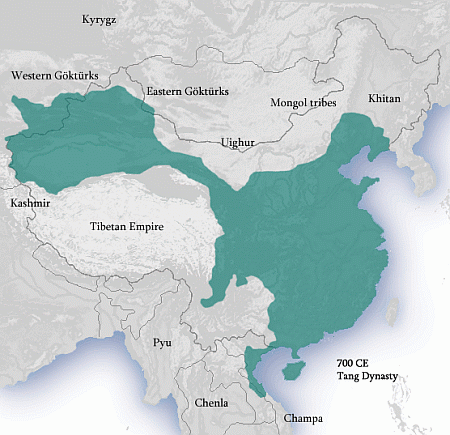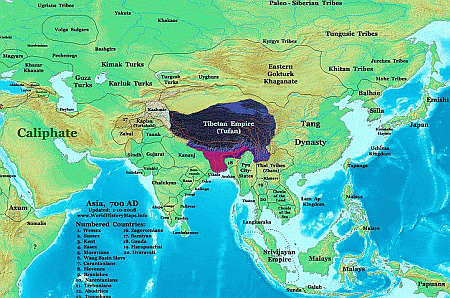|
|
| Chinese
History |
Imperial
China - Tang Empire
|
|
Tang
Dynasty 618–907
( Second Zhou 690–705 )
The Tang dynasty ushered in a new period of prosperity
and gave rise to many arts and crafts that still flourish
today in China. They also accepted both Buddhist and
Taoism, and implemented an advanced system of feudal
land use known as ‘Equal Field System’,
which they developed from their predecessors the Sui.
However, this was from direct government control, and
land was apportioned according to peoples needs, and
not their wealth. They also kept trade routes open,
especially to the West (Overland), and South by sea
(Guangzhou). Trade flourished and the Empire became
very prosperous

Map courtesy of Wikipedia:
http://en.wikipedia.org/wiki/Tang_Dynasty
At its zenith, the Tang controlled a vast country which
included, which in the West included the Pamirs (Tajikistan).
Kingdoms paying tribute (Protectorates) such as: Kashmir,
Nepal, Khotan, Kucha, Kashgar, Japan, Korea, Champa;
and kingdoms located in Amu Darya and Syr Darya River
valleys, which both flow into the Aral Sea
One of the more confusing periods is centred on Tibet.
I will later write about Tibetan history separately,
so briefly:
Originally most Tibetans had common stock with Mongol
tribes, and were known as the Zang Zang or Tufan - the
ancestors of The Bon Culture. They also have wars with
the Burmese tribes, who are also directly related top
some Tibetans.
Eventually Tibet becomes an Empire. Songtsan Gampo became
ruler in 623, and 10 years later send a tribute mission
to the Tang. The price was marriage to the Tang Emperors
daughter. This was refused, but after several wars,
the request was acceded. War between Tibet and China
continued for centuries, and it was not brought to an
end until the formal signing of treaties in 821

Web: www.ThomasLessman.com
Click for full map
After the Goktuks rebellion was put down in 658, Emperor
Gaozong established Protectorates to help control the
massive Empire. Each Protectorate General was given
many and increasing powers. After Xuanzong's reign,
military governors (jiedushi) were given enormous power,
including the ability to maintain their own armies,
collect taxes, and pass their titles on hereditarily.
This is commonly recognized as the beginning of the
end of Tang's central government, and eventually the
Tang themselves
Second Zhou
The dynasty was interrupted briefly by the Second Zhou
Dynasty (690 – 705) when Empress Wu Zetian ( A
former concubine) seized the throne, becoming the first
and only Chinese empress regnant (Empress ruling in
her own right). She is regarded with high esteem by
modern Chinese - especially women.
More Tang
After her death the dynasty collapsed, and the Tang
Emperor Zhongzong retakes control of the Empire for
the Tang
The An Shi uprising of 755 to 763 destroyed the power
of the Tang. An Lushan was given great lower in Hebei
Province, and he later rebelled - founding the rival
Yan Dynasty. He defeated the Tang and took their Capital,
and the court was forced to flee. The Tang eventually
overwhelmed the Yan, and retook Luoyang in alliance
with the help of Abbasid Arabs and the Uyghurs. However,
the Uyghurs demanded colossal payment in silk, which
had disastrous ramifications. Seizing on the instability,
the Tibetans also attacked, taking much of Sichuan Province
After 755, the Equal Field System was quickly abolished
by the powerful military Governors, who seized land
from the poor, and gave it to the wealthy and influential.
The Tang civil service could no longer function effectively,
as it was over-ridden at Regional level. The Tang no
longer had the power to defeat their own military governors
in battle - so we reach a period that can best be described
as a 'stand-off'. The Tang continue to rule China, but
real power lies with various military Governors
From about 860 the Tang Dynasty began to decline due
to a series of rebellions within China itself, and in
the previously subject Kingdom of Nanzhao to the south.
One of the warlords, (Huang Chao), captured Guangzhou
in 879, killing most of the 200,000 inhabitants including
most of the large colony of foreign merchant families
there. In late 880 Luoyang surrendered to him, and in
881 he conquered Chang'an. The emperor Xizong fled to
Chengdu and Huang established a new temporary regime,
which was eventually destroyed by Tang forces, but another
time of political chaos followed.
Post-Tang
The Tang dynasty is overthrown and followed by another
unruly period. Pertinent factors for foreigners to China:
The Dali Empire based from Yunnan province comes and
goes, but brings conflict and understandings between
nomadic Tibetan's and lowland Chinese. You may want
to trace your modern thinking about Tibet back to this
era, or better, 623
Summary
The Tang leave a legacy of flourishing arts, science,
and social development. They brought an era of prosperity
to everyone in China, promoted trade, and extended Chinese
power an influence in all cardinal directions. However,
by empowering Protectorate Generals, they unwittingly
re instigated a world of Warlords, which proved to be
their ultimate downfall |
|
This information is as supplied by Wikipedia, as dated
March 2009 or later, and/or other reliable sources.
Maps (Unless stated otherwise) are provided in association
with Thomas Lessman
Web: www.worldhistorymaps.info
Disclaimer:
Please check this information yourself as it may alter
without notice, and whilst we try our best to ensure
it is correct, please do not hold us responsible for
any errors - this is intended as a simple guide only |
|
| Search
this Website |
|
|
| Our
Friends |
Excellent
& Free Online Chinese Language Portal

Thousands of free print-friendly Chinese reference sheets,
tests and revision aids.
Easy Learning format &
Listen to Spoken Words |

Professional
Visa Services
Company
Formation Packages
.
|

British Foreign Office
Resource and Advice for Travellers Worldwide |

Chinese Embassy in UK
Information About China
International Relations
Visa & Consular |

UK Embassy in China
Information About UK
International Relations
Visa & Consular |

|
Excel
Education |
Languages Courses
Study Abroad
Employability
Summer Camps
Information for Teachers |
|

Excellent and relaxing base to
explore this most beautiful of regions in all China! |
Down The Road.org
How We Traded Our Ordinary Lives For a Global Bicycle Touring Adventure

See
Us in China |

Empowering Underprivileged Children
& Their Communities = Worldwide |
 |

Based in Shangri-la,
Yunnan
Province
Dedicated to Exploring Remote Areas of China
Committed to Nature Conservation and Preserving Ethnic
Cultures & Traditions
|

Based in Xi'an,
China's Premiere Travel Agency and International Travel
Community -
Committed to providing:
Best travel deals & current information for all
International Travellers |

Pearl Dragon
Vast
Online Trading and Information Resource
Link goes to Chinese Tourism and Galleries Section |
|